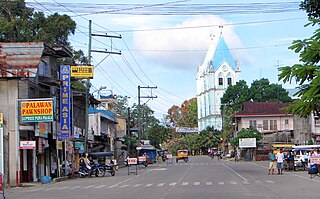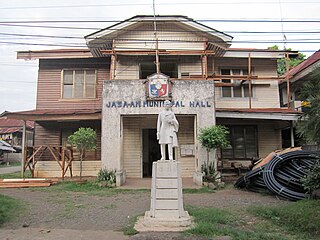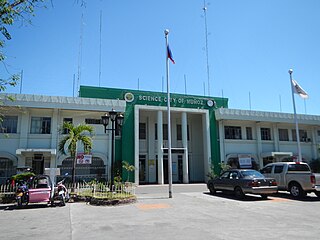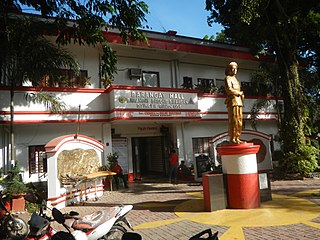
A barangay, historically referred to as a barrio, is the smallest administrative division in the Philippines and is the native Filipino term for a village, district, or ward. In metropolitan areas, the term often refers to an inner city neighborhood, a suburb, a suburban neighborhood, or even a borough. The word barangay originated from balangay, a type of boat used by a group of Austronesian peoples when they migrated to the Philippines.

Mabini, officially the Municipality of Mabini, is a 1st class municipality in the province of Batangas, Philippines. According to the 2020 census, it has a population of 50,858 people.

Prosperidad, officially the Municipality of Prosperidad, is a 1st class municipality and capital of the province of Agusan del Sur, Philippines. According to the 2020 census, it has a population of 88,321 people.

Talisay, officially the City of Talisay, is a 4th class component city in the province of Negros Occidental, Philippines. According to the 2020 census, it has a population of 108,909 people.

Calape, officially the Municipality of Calape, is a 3rd class municipality in the province of Bohol, Philippines. According to the 2020 census, it has a population of 33,079 people.

Alitagtag, officially the Municipality of Alitagtag, is a 4th class municipality in the province of Batangas, Philippines. According to the 2020 census, it has a population of 26,819 people.

Paombong, officially the Municipality of Paombong, is a 3rd class municipality in the province of Bulacan, Philippines. According to the 2020 census, it has a population of 55,696 people.

Paniqui, officially the Municipality of Paniqui, is a 1st class municipality in the province of Tarlac, Philippines. According to the 2020 census, it has a population of 103,003 people. It is the birthplace of the 11th President of the Philippines, Corazon Aquino.

Cagayancillo, officially the Municipality of Cagayancillo, is a 6th class municipality in the province of Palawan, Philippines. According to the 2020 census, it has a population of 6,884 people.

Balingasag, officially the Municipality of Balingasag, is a 2nd class municipality in the province of Misamis Oriental, Philippines. According to the 2020 census, it has a population of 74,385 people.

Jasaan, officially the Municipality of Jasaan, is a 2nd class municipality in the province of Misamis Oriental, Philippines. According to the 2020 census, it has a population of 57,055 people.

Muñoz, officially the Science City of Muñoz, is a 4th class component city in the province of Nueva Ecija, Philippines. According to the 2020 census, it has a population of 84,308 people.

Poblacion is the common term used for the administrative center, central, downtown, old town or central business district area of a Philippine city or municipality, which may take up the area of a single barangay or multiple barangays. It is sometimes shortened to Pob.
The Philippines is divided into four levels of administrative divisions, with the lower three being defined in the Local Government Code of 1991 as local government units (LGUs). They are, from the highest to the lowest:
- Regions are mostly used to organize national services. Of the 17 regions, only one—the Bangsamoro Autonomous Region in Muslim Mindanao—has an elected government to which the central government has devolved competencies.
- Provinces, independent cities, and one independent municipality (Pateros)
- Component cities and municipalities within a province
- Barangays within a city or municipality

Bagong Silangan is a barangay located in the 2nd district of Quezon City, Philippines. Nearby barangays are Commonwealth, Batasan Hills and Payatas. Separated by a river in the east, the barangay leads to the Municipality of San Mateo in the province of Rizal.

A purok is an informal division within a barangay in the Philippines. While not officially considered a local government unit (LGU), a purok often serves as a unit for delivering services and administration within a barangay.
A barangay captain, or a barangay chairperson, is the highest elected official in a barangay, the smallest level of administrative divisions of the Philippines. Sitios and puroks are sub-divisions of barangays, but their leadership is not elected. As of March 2022, there are 42,046 barangays and therefore 42,046 barangay captains.
In the Philippines, local government is divided into three levels: provinces and independent cities, component cities and municipalities, and barangays, all of which are collectively known as local government units (LGUs). In some area, above provinces and independent chartered cities, is an autonomous region, the Bangsamoro Autonomous Region in Muslim Mindanao is an example. In towns and some cities they remit their revenue to national government and goes back in a form of IRA. Below barangays in some cities and municipalities are sitios and puroks. All of these, with the exception of sitios and puroks, elect their own executives and legislatures. Sitios and puroks are often but not necessarily led by an elected barangay councilor.

Sumpong is an urban barangay of the City of Malaybalay in the Province of Bukidnon, Philippines. According to the 2015 census, Sumpong has a population of 9,302 people. It is bounded to the north by Kibalabag, to the east by Can-ayan, to the south by the Poblacion District, and to the west by Kalasungay.

Moonwalk, officially Barangay Moonwalk, is one of Parañaque's 16 barangays and is part of Parañaque's 2nd district. It was created under Presidential Decree No. 1321 signed in by President Ferdinand Marcos on April 3, 1978, From the latest population census of The Philippines (2015) Moonwalk has a population of 67,723.


















